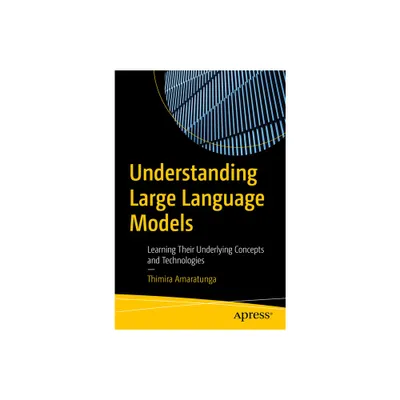Home
LLM Engineer's Handbook: Master the art of engineering large language models from concept to production
Loading Inventory...
Barnes and Noble
LLM Engineer's Handbook: Master the art of engineering large language models from concept to production
Current price: $59.99


Barnes and Noble
LLM Engineer's Handbook: Master the art of engineering large language models from concept to production
Current price: $59.99
Loading Inventory...
Size: Paperback
*Product Information may vary - to confirm product availability, pricing, and additional information please contact Barnes and Noble
Step into the world of LLMs with this practical guide that takes you from the fundamentals to deploying advanced applications using LLMOps best practices
Key Features
Build and refine LLMs step by step, covering data preparation, RAG, and fine-tuning
Learn essential skills for deploying and monitoring LLMs, ensuring optimal performance in production
Utilize preference alignment, evaluation, and inference optimization to enhance performance and adaptability of your LLM applications
Book Description
Artificial intelligence has undergone rapid advancements, and Large Language Models (LLMs) are at the forefront of this revolution. This LLM book offers insights into designing, training, and deploying LLMs in real-world scenarios by leveraging MLOps best practices. The guide walks you through building an LLM-powered twin that’s cost-effective, scalable, and modular. It moves beyond isolated Jupyter notebooks, focusing on how to build production-grade end-to-end LLM systems. Throughout this book, you will learn data engineering, supervised fine-tuning, and deployment. The hands-on approach to building the LLM Twin use case will help you implement MLOps components in your own projects. You will also explore cutting-edge advancements in the field, including inference optimization, preference alignment, and real-time data processing, making this a vital resource for those looking to apply LLMs in their projects. By the end of this book, you will be proficient in deploying LLMs that solve practical problems while maintaining low-latency and high-availability inference capabilities. Whether you are new to artificial intelligence or an experienced practitioner, this book delivers guidance and practical techniques that will deepen your understanding of LLMs and sharpen your ability to implement them effectively.
What you will learn
Implement robust data pipelines and manage LLM training cycles
Create your own LLM and refine it with the help of hands-on examples
Get started with LLMOps by diving into core MLOps principles such as orchestrators and prompt monitoring
Perform supervised fine-tuning and LLM evaluation
Deploy end-to-end LLM solutions using AWS and other tools
Design scalable and modularLLM systems
Learn about RAG applications by building a feature and inference pipeline.
Who this book is for
This book is for AI engineers, NLP professionals, and LLM engineers looking to deepen their understanding of LLMs. Basic knowledge of LLMs and the Gen AI landscape, Python and AWS is recommended. Whether you are new to AI or looking to enhance your skills, this book provides comprehensive guidance on implementing LLMs in real-world scenarios
Key Features
Build and refine LLMs step by step, covering data preparation, RAG, and fine-tuning
Learn essential skills for deploying and monitoring LLMs, ensuring optimal performance in production
Utilize preference alignment, evaluation, and inference optimization to enhance performance and adaptability of your LLM applications
Book Description
Artificial intelligence has undergone rapid advancements, and Large Language Models (LLMs) are at the forefront of this revolution. This LLM book offers insights into designing, training, and deploying LLMs in real-world scenarios by leveraging MLOps best practices. The guide walks you through building an LLM-powered twin that’s cost-effective, scalable, and modular. It moves beyond isolated Jupyter notebooks, focusing on how to build production-grade end-to-end LLM systems. Throughout this book, you will learn data engineering, supervised fine-tuning, and deployment. The hands-on approach to building the LLM Twin use case will help you implement MLOps components in your own projects. You will also explore cutting-edge advancements in the field, including inference optimization, preference alignment, and real-time data processing, making this a vital resource for those looking to apply LLMs in their projects. By the end of this book, you will be proficient in deploying LLMs that solve practical problems while maintaining low-latency and high-availability inference capabilities. Whether you are new to artificial intelligence or an experienced practitioner, this book delivers guidance and practical techniques that will deepen your understanding of LLMs and sharpen your ability to implement them effectively.
What you will learn
Implement robust data pipelines and manage LLM training cycles
Create your own LLM and refine it with the help of hands-on examples
Get started with LLMOps by diving into core MLOps principles such as orchestrators and prompt monitoring
Perform supervised fine-tuning and LLM evaluation
Deploy end-to-end LLM solutions using AWS and other tools
Design scalable and modularLLM systems
Learn about RAG applications by building a feature and inference pipeline.
Who this book is for
This book is for AI engineers, NLP professionals, and LLM engineers looking to deepen their understanding of LLMs. Basic knowledge of LLMs and the Gen AI landscape, Python and AWS is recommended. Whether you are new to AI or looking to enhance your skills, this book provides comprehensive guidance on implementing LLMs in real-world scenarios


















